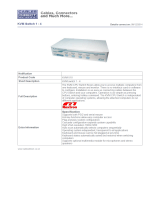
Table of Contents
Contents Page #
Introduction .......................................................................................................................................................................................................................1
Disclaimer .........................................................................................................................................................................................................................1
About This Manual ............................................................................................................................................................................................................1
Features .......................................................................................................................................................................................................................2
Upgradeability...............................................................................................................................................................................................................2
Security.........................................................................................................................................................................................................................2
Flexibility.......................................................................................................................................................................................................................2
On-screen Display Technology ....................................................................................................................................................................................2
Compatibility.................................................................................................................................................................................................................2
Cable Requirements.....................................................................................................................................................................................................3
Package Contents ........................................................................................................................................................................................................3
Rose Electronics Web site ...........................................................................................................................................................................................3
System Overview ..............................................................................................................................................................................................................4
UltraMatrix Remote 2 Models ...........................................................................................................................................................................................5
UltraMatrix Remote 2 Installation – Single Unit ................................................................................................................................................................6
Connecting the KVM station .............................................................................................................................................................................................6
Connecting the Computers / Servers................................................................................................................................................................................7
Connecting to the network ................................................................................................................................................................................................7
Bus / Ring Configuration ...................................................................................................................................................................................................9
Unit Configuration ...........................................................................................................................................................................................................10
IP Input Module Configuration....................................................................................................................................................................................10
Logoff..........................................................................................................................................................................................................................11
Restore mouse functions............................................................................................................................................................................................11
Access mode..............................................................................................................................................................................................................12
Host ............................................................................................................................................................................................................................12
Return to host .............................................................................................................................................................................................................12
Local Configuration .........................................................................................................................................................................................................12
Local Unit Configuration Menu........................................................................................................................................................................................13
Network Configuration ....................................................................................................................................................................................................14
Secure Keys Generation.................................................................................................................................................................................................15
Remote Configuration .....................................................................................................................................................................................................16
User Accounts ............................................................................................................................................................................................................17
Unit Configuration.......................................................................................................................................................................................................18
Time and Date Configuration .....................................................................................................................................................................................20
Network configuration.................................................................................................................................................................................................21
Hosts Configuration....................................................................................................................................................................................................22
Logging and Status ....................................................................................................................................................................................................23
LDAP Configuration....................................................................................................................................................................................................23
KVM Switch Module Configuration .................................................................................................................................................................................24
Configure System menu .............................................................................................................................................................................................25
“Keyboard settings” selections. ..................................................................................................................................................................................26
Appearance settings selections..................................................................................................................................................................................26
Configure Computer menu .........................................................................................................................................................................................27
Computer Name .........................................................................................................................................................................................................27
Keyboard / Mouse ......................................................................................................................................................................................................28
Configure KVM ...........................................................................................................................................................................................................28
Configure Profile.........................................................................................................................................................................................................29
Configure Group .........................................................................................................................................................................................................30
Configure Language ...................................................................................................................................................................................................31
Configure status menu ...............................................................................................................................................................................................31
Save menu .................................................................................................................................................................................................................32
Remote System Operation..............................................................................................................................................................................................33
Connecting using a web browser ...............................................................................................................................................................................33
VNC Viewer Toolbar .......................................................................................................................................................................................................34
Control Tab.................................................................................................................................................................................................................35
Host Tab .....................................................................................................................................................................................................................36
Share Tab...................................................................................................................................................................................................................37
Keyboard commands ......................................................................................................................................................................................................37
Switching using the serial port ........................................................................................................................................................................................38
Serial Device Support.................................................................................................................................................................................................38
Troubleshooting ..............................................................................................................................................................................................................40
Maintenance and Repair ............................................................................................................................................................................................42
Technical Support.......................................................................................................................................................................................................42
Safety..............................................................................................................................................................................................................................43






















